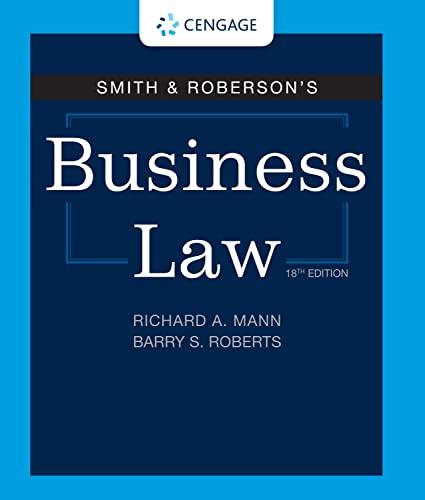Question
For the case Anderson v. Anderson, 2023 SCC 13, answer the following questions. Please provide a good and detailed explanation 2. Court: indicate the name
For the case Anderson v. Anderson, 2023 SCC 13, answer the following questions. Please provide a good and detailed explanation
2. Court: indicate the name of the Court that decided the case. For example: Supreme Court of Canada
3. Facts of the Case: State the main points of the events that triggered the dispute. Be judicious and include details that are necessary to understand what led to the case.
4. Issues or questions before the Court: State the questions of law that the case is addressing (there can be more than one).
5. Procedural History: How did the case arrive at the level of Court you are examining? Note the outcome of each of the lower court decisions. If the case concerns judicial review of an administrative decision or executive action, you should note the outcome of the tribunal or decision-maker.
6. Decision and Action: How did the Court answer the questions in #4 above? Provide a specific answer for each issue. Also identify the action that flows from the decision; typically, this is the judicial "remedy" (e.g., "order for a new trial," monetary damages, "appeal dismissed").
7. Voting Coalitions: Identify the justices in the majority, the justices who concurred together, and the justices who dissented together. On occasion there may be different coalitions on different issues/questions within the same case. In some cases, there will not be a "majority" of judges ( >50% of judges hearing the case ) - in that case, use the largest group (called the "plurality decision") in place of the "majority" (but you should always be clear it is only a plurality of judges).
8. Reasoning / Ratio Decidendi: What reasons did the majority of the Court give for the result at which they arrived? The ratio means you are only looking for reasons, legal doctrines and logic that determined the result.
9. Significant Obiter (if necessary): In some cases, you may find that the majority judgment does say something important that was not necessary to decide the case itself.
10. Concurring opinion(s) (if necessary): Summarize the reasoning of the concurring opinion(s). Why did these justices feel the need to write a separate opinion? Where did they disagree with the majority or what special points did they want to emphasize?
11. Dissenting opinion(s) (if necessary): Summarize the reasoning of the dissenting opinion(s). Why did these justices disagree with the outcome of the case? What reasons did they give to support their contrary opinion? What weaknesses in the majority decision did they identify?
12. Summary/Analysis: What was the main point of the case? How would you sum it up? You might identify the case as part of a pattern of cases in the same issue area. Did it have an impact? Did it overturn a previous precedent? Why was the case important?
Step by Step Solution
There are 3 Steps involved in it
Step: 1

Get Instant Access to Expert-Tailored Solutions
See step-by-step solutions with expert insights and AI powered tools for academic success
Step: 2

Step: 3

Ace Your Homework with AI
Get the answers you need in no time with our AI-driven, step-by-step assistance
Get Started


